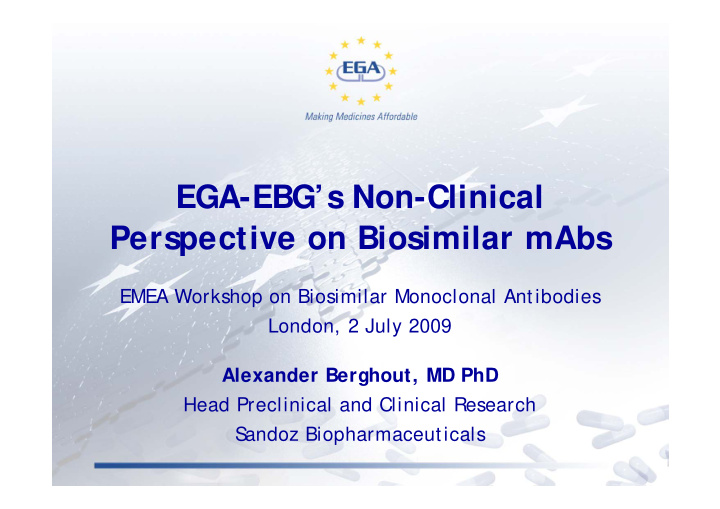



EGA-EBG’s Non-Clinical Perspective on Biosimilar mAbs EMEA Workshop on Biosimilar Monoclonal Antibodies London, 2 July 2009 Alexander Berghout, MD PhD Head Preclinical and Clinical Research S andoz Biopharmaceuticals 1
mAbs are complex and multifunctional proteins Key factors for successful mAb development are already established by the originator � Availability of appropriate bioassays � S election of appropriate animal species � Established antigen cross-reactivity � Pharmacokinetics and pharmacodynamics � Dose selection and treatment schedule � Drug interactions � Known toxicity and safety profile � Immunogenicity � Clinical experience 2
Biosimilar mAbs can be developed using the same principles as for less complex biosimilar products Broad experience with the reference product will allow for focused preclinical development of the biosimilar Clinically relevant PD effects of biosimilar and reference product are compared in appropriate species Nonclinical toxicity in one repeat dose study, including toxicokinetic measurements / local tolerance � Determination of antibody titres, neutralizing capacity � Duration appropriate to allow detection of relevant differences in toxicity and/ or immune responses « EMEA/ CHMP/ 42832/ 05 » 3
To what extent do we ask for non-clinical studies in relevant species, given that the relevant species is often monkey and thus the number of animals per group is limited? Relevant species and toxicity profile for reference product is well-established Non-clinical studies are more suitable to compare dose-response than clinical trials Unnecessary duplication of toxicity studies with reference product should be avoided The use of new methodologies such as modeling, simulation, and biomarkers should be explored to optimize study design 4
How could PD measures ("fingerprinting") be supplementary to quality development? mAbs are multifunctional proteins Functional bioassays to measure the principal mechanisms of action are indispensable in the target directed development of a biosimilar � Engineering � S electing the desired clones � Final drug product development All established effector functions should be investigated 5
For antitumoural mAbs, to what level would a comparison on the functional level beside ADCC/CDC (if relevant) be required? What level is feasible (e.g. signalling events)? Originator anti-tumoural mAbs are generally selected by functional bioassays Functional bioassays will therefore usually be sufficient to establish the comparability of mAbs including antitumoural mAbs It may be expected that identical Fab binding to the target cell receptor will control signalling events in the same way In case modulation of signalling is the predominant function, respective analysis may be required 6
What is the impact of formulation on in vivo behaviour (injection site and infusion rate comparability)? How could it best be studied? In general, the formulation, injection site and infusion rate will be similar for the reference product and the biosimilar product Comparability will be confirmed in human studies The best way to explore the impact of formulation on in vivo behaviour will be in a relevant animal model The use of new methodologies such as modeling and simulation should be considered 7
Conclusions All biosimilars including mAbs follow the same principles of focused preclinical development mAbs are multifunctional proteins requiring an extended set of bioassays The use of new methodologies should be explored to optimize study designs Unnecessary duplication of toxicity studies with reference product should be avoided 8
Recommend
More recommend